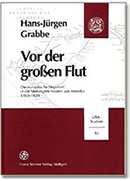Before the Great Tidal Waves
Before the Great Tidal Waves is the first large-scale study
of the influx of Europeans to America during the early national period.
The book endeavors to build a bridge between recent scholarship on the
"Atlantic World" and research on nineteenth-century mass migration.
Most scholars of immigration to the United States have focused on the
years after 1820 on the assumption that the scarcity of data for the
young republic and the low contemporary estimates of immigration warranted
only cursory treatment of the post-revolutionary era. Scholars of early
American history, on the other hand, have rarely ventured beyond the
revolutionary period. Marianne Wokeck's recent monograph Trade in
Strangers: The Beginnings of Mass Migration to North America ends
in 1775 but looks at migration and its economic underpinnings from the
American and the European perspectives.
One aim pursued in my work was to provide reliable statistics for European
immigrants entering Philadelphia during the entire period under examination
and for other major ports during the crucial years after the War of
1812. This data base was augmented by scattered contemporary emigration
and immigration data pertaining to the United States, the British maritime
colonies, and Canada to allow for an estimate that sets the number of
immigrants to the U.S. from 1783 to 1820 at 366,000, some 46 percent
larger than the traditional figure of 250,000. Since the period under
consideration was one of almost continuous strife in Europe, of naval
warfare and blockades, and of sharp economic up- and downswings, migration
flowed more or less freely only for short periods. Then, however, contemporaries
thought they witnessed a "torrent" of newcomers.
Their point of reference was colonial immigration and not modern mass
migration. My study shows that patterns of emigrant transportation and
immigration to British North America and the United States which had
developed during the eighteenth century persisted until about 1820.
By this time, it had become clear to prospective emigrants, merchants
engaged in the transportation business, and would-be employers of immigrant
labor that the traditional destinations of ships carrying European passengers-above
all Philadelphia and, to a lesser extent, Baltimore-were no longer the
most desirable ports of entry. The seminal shift to New York in trade
and in passenger traffic has been attributed to the opening of the Erie
Canal in 1824, but it was foreshadowed by the shifting of the linseed
trade from Philadelphia to New York, which began bringing passengers
from Ireland into the northern port as a return cargo.
This brings me to the second major aim pursued in Before the Great
Tidal Waves. I have utilized hitherto largely untapped archival
sources on both sides of the Atlantic in an integrative study of economic,
social, political, and human conditions pertaining to the so-called
push and pull forces and to the actual process of migration. Several
methodological approaches have been employed: The book contains a quantitative
examination of transatlantic migration, an economic analysis of transatlantic
trade and of market forces in Europe and America, a study of the maritime
carrying trade down to the microeconomic level, an examination of legislative
and governmental parameters bearing upon the movement of people, and,
finally, a study of the decision-making process and of the actual migration
process based on the accounts of individuals.
What emerges is a picture of a transitional period between premodern
and modern times. The transitional character is clearly evident in the
disappearance of the redemptioner system and of immigrant indentured
servitude in the United States. Here, my findings go beyond those of
economic historians. In addition to market forces, I attribute importance
to the revisions of state insolvency laws which after 1790 increasingly
favored debtors. The pivotal factor, however, was the growing reluctance
of Americans, particularly German-Americans, to accept white bound labor
and the equally growing determination of immigrants to avoid servitude
even though they had entered the country on a redemptioner loan agreement.
Sources show that by about 1815 immigrants to the United States managed
to rid themselves of an old world deferential mentality which up to
this time had been one of the foundations of white servitude.
My overall conclusion is that from the vantage point of immigration
history the eighteenth century ended around 1820. On the other hand,
I maintain that developments attributed by historians to the mid nineteenth-century
were foreshadowed if not anticipated earlier in the century. This is
the case, for example, regarding Oliver MacDonagh's observation that
social legislation and administrative action in Great Britain during
the 1830s and 1840s amounted to a "revolution in government," preparing
the way for the modern interventionist state. My research shows that
already the British and American passenger acts and the Pennsylvania
and New York health and poor laws passed at the beginning of the nineteenth
century were remarkably effective both in curbing the flow of people
across the Atlantic, in maintaining decent conditions of ocean travel,
and, when this was deemed desirable, in opening the flood valves.
Hans-Jürgen Grabbe
|
|

Hans-Jürgen Grabbe, Vor der großen Flut: Die europäische Migration in die Vereinigten Staaten von Amerika 1783–1820, USA-Studien 10 (Stuttgart: Franz Steiner Verlag, 2001). 458pp.
|